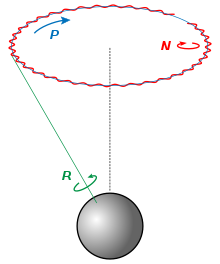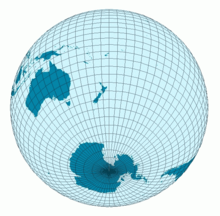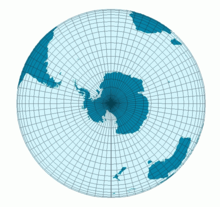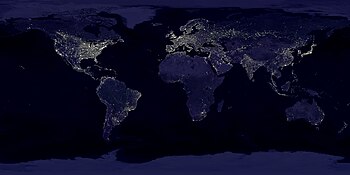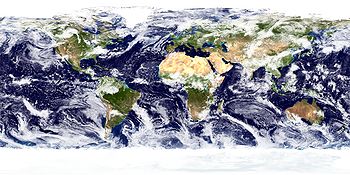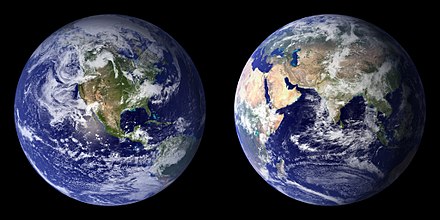earth
| earth |
|
|---|---|
| Blue Marble , an image of the Earth from Apollo 17 on December 7, 1972 | |
| Properties of the orbit | |
| Major semi-axis | 1 AE (149.6 million km) |
| Perihelion - aphelion | 0.983-1.017 AU |
| eccentricity | 0.0167 |
| Inclination of the orbit plane | 0.0001 ° |
| Sidereal orbital period | 365.256 d |
| Mean orbital velocity | 29.78 km / s |
| Physical Properties | |
| Equatorial diameter * | 12,756.27 km |
| Pole diameter * | 12,713.50 km |
| Dimensions | 5.9724 x 10 24 kg |
| Medium density | 5.514 g / cm 3 |
| Gravitational acceleration * | (9.790-9.832) m / s 2 |
| Escape speed | 11.186 km / s |
| Rotation period | 23 h 56 min 4 s |
| Inclination of the axis of rotation | 23.44 ° |
| Geometric albedo | 0.434 |
| Properties of the atmosphere | |
| Pressure * | 1.014 bar |
|
Temperature * min. - average - max. |
184 K (−89 ° C ) 288 K (+15 ° C) 330 K (+57 ° C) |
Main ingredients
|
|
| * based on the zero level of the planet | |
| miscellaneous | |
| Moons | moon |

|
|
| From left to right: size comparison between the edge of the sun , Mercury , Venus , Earth, Mars , Jupiter , Saturn , Uranus and Neptune (true-to-scale photomontage of the sizes, but not the distances) | |
The Earth is the densest , fifth largest and the sun third closest planet of the solar system . It is the place of origin and home of all known living beings . It is more than 12,700 kilometers in diameter and around 4.6 billion years old. The term “ earth-like planets ” was coined according to their predominant geochemical properties . The earth's astronomical symbol is or .
![]()
![]()
Since about two thirds of the earth's surface consists of water and therefore the earth appears predominantly blue when viewed from space , it is also called the blue planet . It is also metaphorically referred to as " Spaceship Earth ".
As the basis of human existence, the earth plays a prominent role in all religions as a holy wholeness ; in several ethnic , folk and historical religions either as the deification of a " mother earth " or as a personified earth goddess .
etymology
The Common Germanic noun earth in Middle High German , in Old High German erda based with cognates in other Indo-European languages on ER .
Orbit
According to Kepler's first law, the earth moves in an elliptical orbit around the sun. The sun is in one of the focal points of the ellipse. The main axis of the ellipse connects the point of the orbit furthest from and closest to the sun. The two points are called aphelion and perihelion . The mean of the aphelion and perihelion distance is the length of the major semi-axis of the ellipse and is about 149.6 million km. This length originally defined the astronomical unit (AU), which is mainly used as an astronomical unit of length for distances within the solar system.
The aphelion is 1.017 AU (152.1 million km) and the perihelion is 0.983 AU (147.1 million km). The ellipse thus has an eccentricity of 0.0167. The passage of aphelion occurs around July 5th and the passage of perihelion around January 3rd. The earth orbits the sun in 365 days, 6 hours, 9 minutes and 9.54 seconds; this period is also called the sidereal year . The sidereal year is 20 minutes and 24 seconds longer than the tropical year on which the civil year of the calendar calculation is based. The orbital speed of the earth is on average 29.78 km / s, in perihelion 30.29 km / s and in aphelion 29.29 km / s; thus the earth covers a distance the length of its diameter in a good seven minutes.
The earth's orbit is on average 0.28 AU (41.44 million km) from the inner neighboring orbit of Venus and on average 0.52 AU (78.32 million km) from the outer neighboring orbit of Mars . However, on average, Mercury is closest to Earth (1.039 AU). There are several co-ordinate objects on the earth's orbit , for more details see: Earth's orbit .
The earth orbits the sun prograd , that is, in the direction of rotation of the sun, which is counterclockwise as seen from the north pole of the earth's orbit plane.
The plane of the earth's orbit is called the ecliptic . The ecliptic is inclined by a good 7 ° to the equatorial plane of the sun. The north solar pole faces the earth most strongly towards the beginning of September, the south solar pole towards the beginning of March. In the solar equatorial plane, the earth is only briefly around June 6th and December 8th.
rotation
The earth rotates progressively towards the east once around its axis relative to the fixed stars in 23 hours, 56 minutes and 4.09 seconds. This time span is called a sidereal day , analogous to the sidereal year . Because the earth also orbits the sun in a prograde manner and is therefore slightly different to the sun on the next day (see figure on the right), a sidereal day is a little shorter than a solar day , which is defined as the time span between two highs of the sun (noon) and in 24 hours is divided.
A point on the earth's equator has a speed of 464 m / s or 1670 km / h due to its own rotation . This causes a centrifugal force that flattens the figure of the earth slightly at the poles and deforms it into an equatorial bulge at the equator . Therefore, compared to a sphere of the same volume, the equatorial radius is 7 kilometers larger and the pole radius 14 kilometers smaller. The equatorial diameter is about 43 km larger than that from pole to pole. Therefore, because of its proximity to the equator , the Chimborazo summit is the point on the earth's surface that is furthest from the center of the earth.
The earth's axis of rotation is 23 ° 26 ′ inclined to the vertical axis of the ecliptic, which means that the northern and southern hemispheres are illuminated differently by the sun at different points on the earth's orbit, which leads to the seasons that shape the earth's climate . The axis inclination direction for the northern hemisphere currently falls within the ecliptical longitude of the constellation Taurus . There, seen from the earth, the sun stands on June 21st at the summer solstice . Since the earth is undergoing aphelion two weeks later, summer in the northern hemisphere falls in the time of its orbit far from the sun.
Precession and nutation
At the earth's equatorial bulge, the tidal forces of the moon and the sun generate a torque that tries to straighten the earth's axis and make it spin. This is called lunisolar precession . As a result, the earth's axis completes a cone orbit in 25,700 to 25,800 years. With this cycle of precession , the seasons shift. In addition, due to the precessional movement of its own orbit with a period of 18.6 years, the moon causes a “nodding” movement of the earth's axis, which is known as nutation . At the same time, the moon stabilizes the inclination of the earth's axis, which without it would tumble up to an incline of 85 ° due to the force of attraction of the planets. See the Moon section for details .
Duration of rotation and tidal forces
On earth, the gravitation of the moon and sun causes the tides of the ebb and flow of the seas. The sun's share is about half that of the moon. The tides also raise and lower the land masses by about half a meter. The tides cause the tidal friction , which slows the earth's rotation and thereby extends the days by about 20 microseconds per year. The rotational energy of the earth is converted into heat and the angular momentum is transferred to the moon, which moves away from the earth by around four centimeters per year. This long suspected effect has been secured by laser distance measurements since 1995. If this deceleration is extrapolated into the future, the earth will one day always turn the same side to the moon, whereby a day on earth would then be about 47 times as long as it is today. Thus the earth is subject to the same effect that already led to the bound rotation (corotation) of the moon.
- For details see: Long-Term Changes in Earth's Rotation and Tides
| Comparison of the distances from Earth, Venus and Mercury to the Sun: |
construction
With its geochemical structure, the earth defines the class of earth-like planets (also called earth-like , terrestrial planets, or rock planets ). Earth is the largest of the four Earth-like planets in the solar system .
internal structure
The earth is made up of iron (32.1%), oxygen (30.1%), silicon (15.1%), magnesium (13.9%), sulfur (2.9%), nickel (1st , 8%), calcium (1.5%) and aluminum (1.4%). The remaining 1.2% share traces of other elements .
According to seismic measurements, the earth consists of three shells: the earth's core, the earth's mantle and the earth's crust. These shells are separated from one another by seismic discontinuity surfaces (discontinuity surfaces). The earth's crust and the uppermost part of the upper mantle together form the lithosphere . It is between 50 and 100 km thick and consists of large and small tectonic plates.
A three-dimensional model of the earth, like all scaled-down replicas of cosmic bodies, is called a globe .
surface
| Area in km 2 | proportion of | |
|---|---|---|
| Total area of the earth | 510,000,000 | 100.0% |
| Water surface | 360,570,000 | 70.7% |
| Land area | 149,430,000 | 29.3% |
| of which permanent human use (residential areas, infrastructure, intensively used areas, agriculture and forestry) 2004 |
72.084.920 | 48.2% |
| as well as rarely and unused “ wilderness regions ” (incl. ice sheets ) 2004 | 77.345.080 | 51.8% |
Due to the centrifugal force of the rotation, the equatorial circumference, at 40,075.017 km, is 67.154 km (0.17%) larger than the polar circumference (meridian circumference) with 40.007.863 km (based on the geodetic reference ellipsoid from 1980 ). The pole diameter of 12,713.504 km is accordingly 42.816 km or 0.34% smaller than the equatorial diameter of 12,756.320 km (based on the reference ellipsoid; the actual numbers differ from this). The differences in scope contribute to the fact that there is no clearly the highest mountain on earth. According to the height above sea level , it is Mount Everest in the Himalayas and according to the distance of the summit from the center of the earth, the volcanic mountain Chimborazo in the Andes , standing on the equatorial bulge . Measured from its own base, Mauna Kea is highest on the large volcanic Hawaiian island rising from the Pacific sea floor.
The earth's surface is about 510 million km². It can be divided into two different hemispheres: a land hemisphere and a water hemisphere . The land hemisphere comprises the greater part of the land area and consists of almost half with 47% land. The area of the water hemisphere contains only 11% land and is dominated by oceans.
37.4% of the earth's land surface is between 1000 and 2000 m above sea level . These are high low mountain ranges , high mountains and plateaus . If you look at the unevenness of the earth's surface on a global scale , they appear rather small. The height of Mount Everest would correspond to an elevation of only around 0.15 mm on a globe the size of a soccer ball.
The earth is the only planet in the solar system that has liquid water on its surface. The oceans contain 96.5% of the total water on earth. The sea water contains an average of 3.5% salt.
The water area has in the current geological epoch a total share of 70.7% at the surface. The remaining 29.3%, the land area , is mainly on seven continents; in the order of their size: Asia , Africa , North America, South America , Antarctica , Europe and Australia (within the framework of plate tectonics, however, as the large western peninsula of the Eurasia continent, Europe has probably never been an independent unit). The area of the world's ocean is broadly divided into three oceans including the tributaries : the Pacific , the Atlantic and the Ind . The deepest point of the sea, Vitja Deep 1 , is in the Mariana Trench , 11,034 m below sea level. The average sea depth is 3,800 m, which is about five times the mean altitude of the continents at 800 m (see hypsographic curve ).
plate tectonics
The number and order of the largest plates roughly correspond to those of the continents they support, with the exception of the Pacific plate. According to plate tectonics, all these plates move relative to one another on the partially melted, viscous rocks of the upper mantle, the 100 to 150 km thick asthenosphere .
Magnetic field
The magnetic field surrounding the earth is generated by a geodynamo . The field resembles a magnetic dipole near the earth's surface . The magnetic field lines exit in the southern hemisphere and re-enter the earth through the northern hemisphere. The magnetic field is deformed in the earth's mantle. The magnetic field is compressed by the solar wind outside of the earth's atmosphere.
The Earth's magnetic poles do not exactly coincide with the geographic poles . The axis of the magnetic field was inclined by about 11.5 ° in relation to the earth's axis in 2007 .
the atmosphere
The earth's atmosphere changes continuously into space , so that it is not sharply delimited at the top. Their mass is about 5.13 × 10 18 kg and thus makes up almost one millionth of the earth's mass. In the atmosphere at sea level, the mean air pressure under standard conditions is 1013.25 hPa . The atmosphere on the ground consists mainly of 78% by volume nitrogen , 21% by volume oxygen and 1% by volume noble gases , predominantly argon . In addition, there is 0.4% by volume of water vapor in the entire earth's atmosphere. The proportion of carbon dioxide, which is important for the greenhouse effect, has increased due to human influence and is currently around 0.04% by volume.
The temperature extremes measured meteorologically on earth are −89.2 ° C (measured on July 21, 1983 at an altitude of 3420 meters in the Vostok station in Antarctica ) and 56.7 ° C (measured on July 10, 1913 in Death Valley at 54 m below sea level ). The mean temperature near the ground is 15 ° C. At this temperature, the speed of sound in the air at sea level is 340 m / s.
The earth's atmosphere scatters the short-wave, blue spectral component of sunlight about five times more than the long-wave, red, and thus colors the sky blue when the sun is high. The surface of the seas and oceans also appears blue from space, which is why the earth has also been called the “blue planet” since the beginning of space travel. However, this effect is due to the stronger absorption of red light in the water itself. The reflection of the blue sky on the surface of the water is only of secondary importance.
climate
Climate and vegetation zones

The earth is divided into climatic zones based on the intensity of solar radiation , which extend from the North Pole to the equator - and in the southern hemisphere are mirror images. The climates shape the vegetation , which is similarly divided into different zonal biogeographical models .
| climate zone | approximate latitude north / south |
Average temperature |
|---|---|---|
| Polar zone / cold zone | Pole up to 66.56 ° (polar circles) | approx. 0 ° C |
| Temperate zone | 66.56 ° to 40 ° | approx. 8 ° C |
| subtropics | 40 ° to 23.5 ° (turning circles) | approx. 16 ° C |
| Tropics | 23.5 ° to the equator | approx. 24 ° C |
The further a climate zone is from the equator and the nearest ocean, the more the temperatures fluctuate between the seasons.
Polar zone
The polar regions lie on the poles. The north lies within the Arctic Circle and includes the Arctic , in the center of which lies the Arctic Ocean . The southern part is accordingly within the Arctic Circle and includes Antarctica , to which most of the continent Antarctica belongs.
The polar regions are characterized by a cold climate with lots of snow and ice, polar lights , as well as polar day with the midnight sun and the polar night , both of which can last up to six months.
The vegetation of the polar and sub-polar eco- zones ranges from the cold deserts (which have only small, island-like plant occurrences with very few shallow species) to the treeless, grass, shrub and moss-covered tundras .
Temperate zone
The temperate climatic zone extends from the polar circles to the fortieth degree of latitude and is divided into a cold and cool temperate zone . In this zone, the seasons differ greatly, but this decreases somewhat towards the equator . Another feature is the differences in the lengths of day and night, which vary greatly depending on the season. These differences increase more and more towards the pole.
The vegetation is made up of forests ( boreal coniferous forests in the north of the northern hemisphere , nemoral or Australian mixed and deciduous forests of the humid mid-latitudes in the areas closer to the equator ) as well as grass steppes and cold - winter semi-deserts and deserts ( prairies and great basin in North America; Eurasian steppe and deserts of Central Asia , pampas and Patagonian dry steppes ).
subtropics
The subtropics (partly also warm-temperate climatic zones ) lie in geographical latitude between the tropics in the direction of the equator and the temperate zones in the direction of the poles, approximately between 25 ° and 40 ° north or south latitude. In the subtropics, tropical summers and non-tropical winters predominate. The subtropics can be further subdivided into dry, winter humid, summer humid and always humid subtropics.
A subtropical climate is widely defined as having a mean temperature in the year over 20 degrees Celsius and a mean temperature in the coldest month of below 20 degrees.
The differences between the lengths of day and night are relatively small.
The vegetation mainly includes dry open landscapes ( hot semi-deserts and deserts such as the Sahara and the Australian deserts ), but also wooded areas ( light hard-leaved forests of the winter- humid "Mediterranean climates" and dense laurel forests of the ever-humid subtropics ).
Tropics
The tropics are located between the northern and southern tropics . In the tropics, day and night are always roughly the same length (between 10.5 and 13.5 hours).
The tropics can be subdivided into the always humid and alternately humid tropics. Only the humid tropics have two climatically different seasons: dry and rainy seasons.
In terms of vegetation , the tropics are subdivided into the summer-moist, dry and moist savannas as well as the rainforests of the ever-moist tropics ( Amazon basin , Congo basin , Malay archipelago and New Guinea ). The greatest diversity of species and biodiversity on earth is concentrated in the tropics .
Seasons
The seasons are primarily caused by radiation from the sun and as a result can be characterized by fluctuations in temperature and / or the amount of precipitation. In the temperate zone, this is usually understood to mean the change in daily high or low temperatures. In the subtropics and to a greater extent in the tropics, these temperature differences are superimposed with fluctuations in the monthly mean of precipitation, and their perceptibility is reduced.
The differences arise from the inclination of the equator against the ecliptic . As a result, the zenith of the sun moves back and forth between the northern and southern tropics (hence the name tropic). In addition to the different irradiation, this also creates the differences in the lengths of day and night, which vary greatly depending on the season. These differences increase more and more towards the pole.
The hike takes place annually as follows:
- December 21 (winter solstice): The sun is over the Tropic of Capricorn (Tropic of Capricorn). The shortest day of the year is now in the northern hemisphere and the longest day in the southern hemisphere. The astronomical winter begins. In the northern hemisphere, the mean (daily or monthly) temperature reaches its lowest point with some delay due to the now low solar radiation. At the north pole is the middle of the polar night and at the south pole the middle of the polar day.
- March 19-21: Equinox: Spring begins astronomically in the north and autumn in the south. The sun is at the level of the equator.
- June 21 (summer solstice): The sun is over the Tropic of Cancer (Tropic of Cancer). Longest day in the north and shortest day in the south. The astronomical summer begins in the northern hemisphere and the astronomical winter begins in the southern hemisphere. In the northern hemisphere, the mean daily or monthly temperature reaches its highest point with some delay due to the higher solar radiation. At the North Pole is the middle of the polar day and at the South Pole is the middle of the polar night.
- September 22nd or 23rd: Equinox: astronomically autumn begins in the north, spring in the south. The sun is back at the equator.
In contrast to this, in meteorology the beginning of the seasons is brought forward to the beginning of the month (December 1st, March 1st, etc.).
Global energy balance
The energy balance of the earth is essentially determined by the radiation from the sun and the radiation from the earth's surface or atmosphere, i.e. by the radiation balance of the earth . The remaining contributions, totaling around 0.02%, are well below the measurement accuracy of the solar constants and their fluctuations in the course of a sunspot cycle .
The geothermal energy contribution generated by radioactive decay accounts for around 0.013% , around 0.007% comes from human use of fossil and nuclear fuels and around 0.002% is caused by tidal friction .
The earth has a geometric albedo averaging 0.367, with a significant proportion being due to the clouds in the earth's atmosphere. This leads to a global effective temperature of 246 K (−27 ° C). However, due to a strong atmospheric greenhouse effect or counter-radiation, the average temperature on the ground is around 288 K (15 ° C), with the greenhouse gases water and carbon dioxide making the main contribution.
Influence of man
The interactions between living beings and the climate have now reached a new level due to the increasing influence of humans. While around 1.8 billion people populated the earth in 1920, the earth 's population had grown to just under 6.7 billion by 2008. Strong population growth is still to be expected in developing countries for the foreseeable future, while in many highly developed countries the population is stagnating or growing only very slowly, but their industrial influence on nature continues to grow. According to an expert forecast from February 2005 by the United Nations, the world 's population should grow to 7 billion by 2013 and to 9.1 billion by 2050.
Since many people strive for a higher standard of living , they consume more, which, however , uses more energy . Most of the energy comes from burning fossil fuels , so the carbon dioxide content in the atmosphere increases. Since carbon dioxide is one of the most important greenhouse gases , this has led to anthropogenic climate change , which, according to most experts, will significantly increase the global average temperature. The consequences of this process will have a significant impact on the climate, oceans , vegetation , wildlife and people. The primary consequences are more frequent and intensified weather events , a rising sea level as a result of melting inland ice and the thermal expansion of the water, as well as a shift of the climatic and vegetation zones to the north. If the international climate protection efforts are too unsuccessful, a scenario of incalculable risks for the earth can arise, which is also referred to by the media as a " climate catastrophe ".
moon

The moon orbits the earth as a natural satellite . The ratio of the diameter of the moon to its planet of 0.273 (mean moon diameter 3,476 km to mean earth diameter 12,742 km) is significantly larger than that of the natural satellites of the other planets.
As far as we know today, the moon was formed after the proto-earth collided with the Mars-sized Theia .
The moon stabilizes the earth's axis , the inclination of which fluctuates by ± 1.3 ° around the mean 23.3 °. This fluctuation would be much larger if the precession period of about 26,000 years were in resonance with one of the many periodic disturbances caused by the gravitational pull of the other planets and affecting the Earth's orbit. Currently, only a minor perturbation from Jupiter and Saturn, with a period of 25,760 years, is affecting Earth, but it is too weak to change much. As simulations show, the inclination of the earth's axis would be unstable in the current state of the solar system if the inclination were in the range of about 60 ° to 90 °; the actual inclination of a good 23 °, on the other hand, is far enough away from strong resonances and remains stable.
If the earth had no moon, however, the precession period would be about three times as great because the moon causes about two thirds of the precession speed and without it only one third of the sun would be left. This significantly longer precession period would be close to many faults, of which the strongest with periods of 68,750, 73,000 and 70,800 years would cause considerable resonance effects. Under these circumstances, calculations show that all axis inclinations between 0 ° and about 85 ° would be unstable. A typical fluctuation from 0 ° to 60 ° would take less than 2 million years.
The moon prevents these resonances and so with its relatively large mass stabilizes the inclination of the earth's axis against the ecliptic. This also stabilizes the seasons and thus creates favorable conditions for the development of life on earth.
| Size ratio between earth and moon and their distance to each other: | |||
| L 4 and L 5 | |||
| earth | moon | ||
Other companions
In addition to the moon, there are smaller objects close to the earth : co-ordinate asteroids , which do not orbit the earth, but orbit the sun in a 1: 1 orbital resonance on a horseshoe orbit . Examples are the 50 to 110 meter asteroid 2002 AA 29 and the 10 to 30 meter asteroid 2003 YN 107 .
Companions can also be found in or at the Lagrange points L 4 and L 5 of the earth, who are then called Trojans . So far, a single natural Trojan horse on earth has been discovered, the approximately 300-meter-large asteroid 2010 TK 7 .
Origin of the earth
| The earth as a "pale blue point", recorded by the Voyager 1 space probe on February 14, 1990 from a distance of about 40.5 AU (approx. 6 billion km) |
Origin of the earth's body
The earth, like the sun and its other planets, was formed about 4.6 billion years ago when the solar nebula condensed. As is generally believed today, the Earth was heavily bombarded by asteroids for the first 100 million years. Today only a few objects fall from the sky. Most of the objects there appear as meteors and are smaller than 1 cm. In contrast to the moon, almost all impact craters on earth have disappeared due to geological processes. The young earth was heated by the kinetic energy of the impacts during the heavy bombardment and the heat produced by the radioactive decay until it was mostly melted. Then the earth's body differentiated itself gravitationally into an earth's core and an earth's mantle . The heaviest elements, especially iron , sank to the center of gravity of the earth, and heat was also released. Light elements, especially oxygen , silicon and aluminum , rose to the top and mainly silicate minerals formed from them, which are also the rocks of the earth's crust . Since the earth mainly consists of iron and silicates, like all terrestrial planets it has a very high average density of 5.515 g / cm³.
The development of the earth's surface in the interplay of geological and biological factors is called earth history.
Origin of the water
Where the water on earth comes from, and in particular why the earth has significantly more water than the other earth-like planets, has not yet been satisfactorily clarified. Some of the water is likely to have been gassed out of magma as water vapor, i.e. ultimately coming from the interior of the earth . But it is questionable whether this is sufficient for the current amount of water. Other large proportions could come from impacts by comets , trans-Neptunian objects or water-rich asteroids ( protoplanets ) from the outer areas of the asteroid belt . Measurements of the isotope ratio of deuterium to protium (D / H ratio) rather point to asteroids, since similar isotope ratios were found in water inclusions in carbonaceous chondrites as in ocean water, whereas the isotope ratio of comets and trans-Neptunian objects according to previous ones Measurements do not match those of terrestrial water.
Life
The earth is the only known planet on which a biosphere with life forms exists. As far as we know today, life began relatively quickly after the end of the last heavy bombardment of large asteroids: the last phase of the formation of the solar system , which lasted from the formation of the earth from about 4.6 to about 3.9 billion years ago. Then the earth cooled down so that a stable crust formed on which water could then collect. As evidence suggests, which, however, is not recognized by all scientists, life developed already (geologically) a short time later:
In 3.85 billion year old sedimentary rocks from the Isua region in southwest Greenland, anomalies were discovered in the proportions of carbon isotopes that could indicate biological metabolism . Instead of sedimentary rock, the rock can also only be heavily modified effluent rock, without indicating life. The oldest direct but controversial evidence of life are structures in 3.5 billion year old rocks of the Warrawoona Group in northwest Australia and in the Barberton greenstone belt in South Africa, which are interpreted as being caused by cyanobacteria . The oldest definite traces of life on earth are 1.9 billion year old fossils from the Gunflint Formation in Ontario, which could have been bacteria or archaea .
The chemical and biological evolution are inextricably linked with the history of the earth's climate . Although at the beginning the sun shone significantly less than today (cf. paradox of the weak young sun ), there are indications of earthly life, basically comparable to today's, "since there were stones".
The metabolism of plant life , i.e. photosynthesis , enriched the earth's atmosphere with molecular oxygen so that it got its oxidizing character. In addition, the plant cover noticeably changed the albedo and thus the energy balance of the earth.
The forms of life on earth emerged from the permanent interaction between life and the prevailing climatic, geological and hydrological environmental conditions and form the biosphere: a systemic whole that is described in large-scale biomes , ecosystems and biotopes .
human and environment
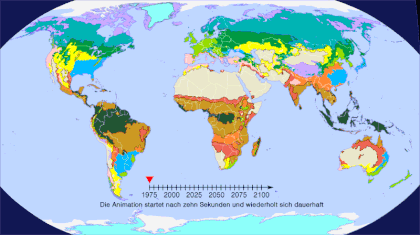
The genus Homo has existed on earth for around 3 to 2 million years , to which the anatomically modern human , which has existed for around 300,000 years, belongs. Until the invention of plant cultivation and animal husbandry, people lived in the Middle East (approx. 11th), in China (approx. 8th) and in the Mexican lowlands (approx. 6th millennium BC) exclusively as hunters and gatherers . Since Neolithic revolution ousted the man cultivated crops and animal breeds in the spread of civilizations , the wild plants and animal breeds still more. Since the industrial revolution at the latest, humans have been influencing the appearance and development of the earth more and more: Large areas of land have been converted into industrial and traffic areas.
This anthropogenic change already had a clearly negative effect in some regions of the world at the beginning of modern times : In Central Europe, for example, a dramatic wood shortage developed in the 16th century , which caused considerable deforestation. This gave rise to the first major movements in Europe and North America for environmental and nature conservation in the 18th and 19th centuries . Pollution and destruction on a global scale increased rapidly in the 20th century. The study “ Limits to Growth ” published in 1972 showed the underlying relationships for the first time in a comprehensive manner. The international environmental action day has been April 22nd since 1990 and is called Earth Day . In 1992 came the first "warning of the world scientific community to mankind" to urgently reduce harmful influences on the earth.
The year 2008 has been declared the International Year of Planet Earth (IYPE) by the United Nations under the auspices of UNESCO . This largest global initiative in the geosciences to date is intended to highlight the importance and benefits of modern geosciences for society and for sustainable development . Numerous events and interdisciplinary projects at international and national level extended from 2007 to 2009 over a period of three years.
In order to quantify the earth's decisive ecological limits, a 28-strong team of scientists headed by Johan Rockström (Stockholm Resilience Center) formulated the Planetary Boundaries :
- Loss of biodiversity
- Sulfur emissions
- Carbon dioxide in the earth's atmosphere
- Thinning of the ozone layer
- Ocean acidification
- Loss of phosphorus from the seas
- Land use intensity
- Freshwater resources
Human impact on the future
*) = Emissions of ozone-depleting halogen compounds as R-11 equivalents in megatons assuming a constant natural emission rate of 0.11 Mt per year
The near future of the earth's surface depends very much on the development of human environmental impact .
To this end, 15,372 scientists from 184 countries published a “second warning to humanity” on November 13, 2017, since there has been no real progress apart from the protection of the ozone layer and fishing quotas: Almost all important ecological indicators have deteriorated drastically. The trends in global warming, deforestation , the increase in dead bodies of water and the reduction in biodiversity are particularly worrying . The scientists see the foundations of human existence seriously endangered and call for short-term countermeasures.
Distant future and the end
The more distant future of the earth is closely tied to that of the sun .
The sun shines on
In the core of the sun, nuclear fusion reduces the number of particles (4 p + 2 e → He 2+ ), but hardly the mass. Therefore, the core will slowly shrink and get hotter. Outside the core, the sun will expand, making the material more permeable to radiation, so that the luminosity of the sun will increase by around 10% over the next 1.1 billion years and by 40% after 3.5 billion years.
Effects on the earth
If the above changes in the sun are assumed to be the main influencing factor on the earth, it is assumed that the earth could remain animate similar to today for about 500 million years. Afterwards, as climate models show, the greenhouse effect becomes unstable and higher temperatures lead to more water vapor in the atmosphere, which in turn will intensify the greenhouse effect. The warm rain will accelerate the inorganic carbon cycle through erosion , as a result of which the CO 2 content of the atmosphere will decrease sharply to around 10 ppm in around 900 million years (compared to 280 ppm in pre-industrial times), so that the animals will starve with the plants . After another billion years, all surface water will have disappeared and the global average temperature of the earth will reach +70 ° C.
Red giant
The increase in luminosity of the sun will continue and accelerate significantly from around seven billion years onwards. The sun will extend as a red giant to today's earth orbit, so that the planets Mercury and Venus will crash and burn up. Contrary to what was initially thought, this will also happen to the earth. As a red giant, the sun will lose around 30% of its mass due to strong solar winds , so that the Earth's orbit radius will theoretically increase to 1.7 AU, but the earth will cause a tidal wave to follow it in the nearby, very diffuse solar surface, which will use its orbital energy consume and so will thwart the escape.
See also
- Earth / dates and numbers
- Position of the earth in the universe
- List of countries in the world (list of all countries and states in the world)
- Envisat (ESA environmental satellite)
- NASA World Wind and Google Earth (computer programs)
- Flat earth (history of the idea of the earth as a disk)
- Gaia hypothesis
- Earth system science
literature
- Cesare Emilliani: Planet Earth. Cosmology, Geology, and the Evolution of Live and Environment. Cambridge University Press 1992, ISBN 0-521-40949-7 .
- Kevin W. Kelley (Editor, on behalf of the Association of Space Explorers ): The Home Planet. Zweiausendeins, Frankfurt am Main 1989. ISBN 3-86150-029-9 .
- JD Macdougall: A Brief History of the Earth. A journey through 5 billion years. Econ Taschenbuchverlag, Munich 2000, ISBN 3-612-26673-X .
- David Oldroyd: The Biography of the Earth. Two thousand and one 1998, ISBN 3-86150-285-2 .
- Karl-August Wirth: Earth . In: Real Lexicon on German Art History . 5th Volume, 1964, Col. 997-1104.
Web links
- Raumfahrer.net special page: Planet Earth
- Onegeology.org : Geological World Map
- NASA Earth Observatory
- Solar System Exploration: Earth. In: NASA.gov. (English).
media
- How old is the earth from the alpha-Centauri television series(approx. 15 minutes). First broadcast on Feb. 4, 2001.
- Why is the earth warm? from the alpha-Centauri television series(approx. 15 minutes). First broadcast on Apr 14, 2002.
- How quickly did the earth come into being? from the alpha-Centauri television series(approx. 15 minutes). First broadcast on Feb 2, 2005.
Individual evidence
- ^ A b David R. Williams: Earth Fact Sheet. In: NASA.gov. April 20, 2020, accessed May 9, 2020 .
- ^ Solar System Exploration: Planet Compare. In: NASA.gov. Retrieved May 10, 2020 .
- ↑ Trends in Atmospheric Carbon Dioxide. In: esrl.noaa.gov. NOAA , accessed May 10, 2020 .
- ↑ Hans-Ulrich Keller: Compendium of Astronomy: Introduction to the Science of the Universe . Franckh-Kosmos Verlags-GmbH & Co. KG, Stuttgart 2016, ISBN 978-3-440-15215-7 , p. 379 ( limited preview in Google Book search).
- ^ Wilhelm Kühlmann : Pantheismus I, published in: Horst Balz et al. (Ed.): Theologische Realenzyklopädie , Volume 25: "Ochino - Parapsychologie". Walter de Gruyter, Berlin, New York 1995/2000, ISBN 978-3-11-019098-4 . P. 628.
- ↑ The dictionary of origin (= Der Duden in twelve volumes . Volume 7 ). 5th edition. Dudenverlag, Berlin 2014 ( p. 255 ). See also DWDS ( "Earth" ) and Friedrich Kluge : Etymological Dictionary of the German Language . 7th edition. Trübner, Strasbourg 1910 ( p. 117 ).
- ↑ Tom Stockman, Gabriel Monroe, Samuel Cordner: Venus is not Earth's closest neighbor . In: Physics Today . March 12, 2019, doi : 10.1063 / PT.6.3.20190312a (English).
- ↑ Herbert Cerutti: What if the moon didn't exist. In: NZZ Folio . 08/08.
- ↑ a b Last of the wild, v2. In: sedac.ciesin.columbia.edu. "Socioeconomic Data and Applications Center" of the "Center for International Earth Science Information Network (CIESIN)" at Columbia University, New York, accessed on January 27, 2019 (percentages of the study applied to land area in km²).
- ↑ Conradin Burga, Frank Klötzli and Georg Grabherr (eds.): Mountains of the earth - landscape, climate, plant world. Ulmer, Stuttgart 2004, ISBN 3-8001-4165-5 , p. 21.
- ↑ The ratio of 8,848 m mountain height to around 40,000,000 m circumference of the earth such as 1: 4521 is the same as that of 0.0151 cm to around 68 cm in circumference of a football .
- ↑ RF Keeling et al .: Atmospheric CO 2 concentrations (ppm) derived from in situ air measurements at Mauna Loa, Observatory, Hawaii: Latitude 19.5 N, longitude 155.6 W, elevation 3397 m. In: Scripps CO 2 Program , Scripps Institution of Oceanography (SIO), University of California, La Jolla (2011).
- ↑ Global Weather & Climate Extremes at wmo.asu.edu , accessed December 22, 2013.
- ↑ World Creation Day: Man overtaxes the earth. In: zeit.de. August 1, 2018, accessed January 28, 2019 .
- ↑ Confirmed: Moon was created by collision. In: science.orf.at. Retrieved August 23, 2016 .
- ↑ a b Jacques Laskar: Large scale chaos and marginal stability in the solar system . In: Celestial Mechanics and Dynamical Astronomy . tape 64 , no. 1-2 , 1996, ISSN 1572-9478 , pp. 115-162 , Section 3.5: The Chaotic Obliquity of the Planets. , doi : 10.1007 / BF00051610 , bibcode : 1996CeMDA..64..115L .
- ↑ Veizer, Ján (2005): Celestial Climate Driver: A Perspective from Four Billion Years of the Carbon Cycle , Geoscience Canada, Volume 32, No. 1, 2005.
- ^ A b William J. Ripple, Christopher Wolf, Thomas M. Newsome, Mauro Galetti, Mohammed Alamgir, Eileen Crist, Mahmoud I. Mahmoud, William F. Laurance and 15,364 life scientists from 184 countries: World Scientists' Warning to Humanity: A Second Notice , Journal: BioScience, Volume 67, Issue 12, December 1, 2017, published December 13, 2017. Pages 1026-1028.
- ↑ German UNESCO Commission eV: The International Year of Planet Earth 2008 .
- ^ Johan Rockström et al: A safe operating space for humanity. In: Nature . 461, 2009, pp. 472-475. (24 September 2009)
- ↑ a b c I.-J. Sackmann, AI Boothroyd, KE Kraemer: Our Sun. III. Present and Future . In: Astrophysical Journal . 418, 1993, pp. 457-468. bibcode : 1993ApJ ... 418..457S . doi : 10.1086 / 173407 .
- ^ Carl Koppeschaar: ASTRONET. February 20, 2000, accessed December 26, 2012 .
- ↑ JF Kasting: Runaway and Moist Greenhouse Atmospheres and the Evolution of Earth and Venus . In: Icarus . 74, 1988, pp. 472-494. bibcode : 1988Icar ... 74..472K . doi : 10.1016 / 0019-1035 (88) 90116-9 . .
- ^ A b Peter D. Ward and Donald Brownlee: The Life and Death of Planet Earth: How the New Science of Astrobiology Charts the Ultimate Fate of Our World . Times Books, New York 2003, ISBN 0-8050-6781-7 .
- ^ Damian Carrington: Date set for desert Earth , BBC News. February 21, 2000. Retrieved December 23, 2008.
- ↑ K.-P. Schröder, Robert Connon Smith: Distant future of the Sun and Earth revisited . In: Monthly Notices of the Royal Astronomical Society . 386, 2008, p. 155. arxiv : 0801.4031 . doi : 10.1111 / j.1365-2966.2008.13022.x . See also Jason Palmer: Hope dims that Earth will survive Sun's death. In: newscientist.com. February 22, 2008, accessed November 22, 2018 .




